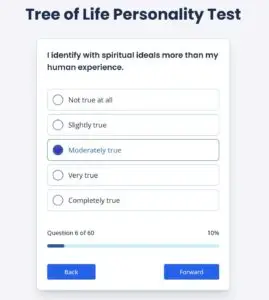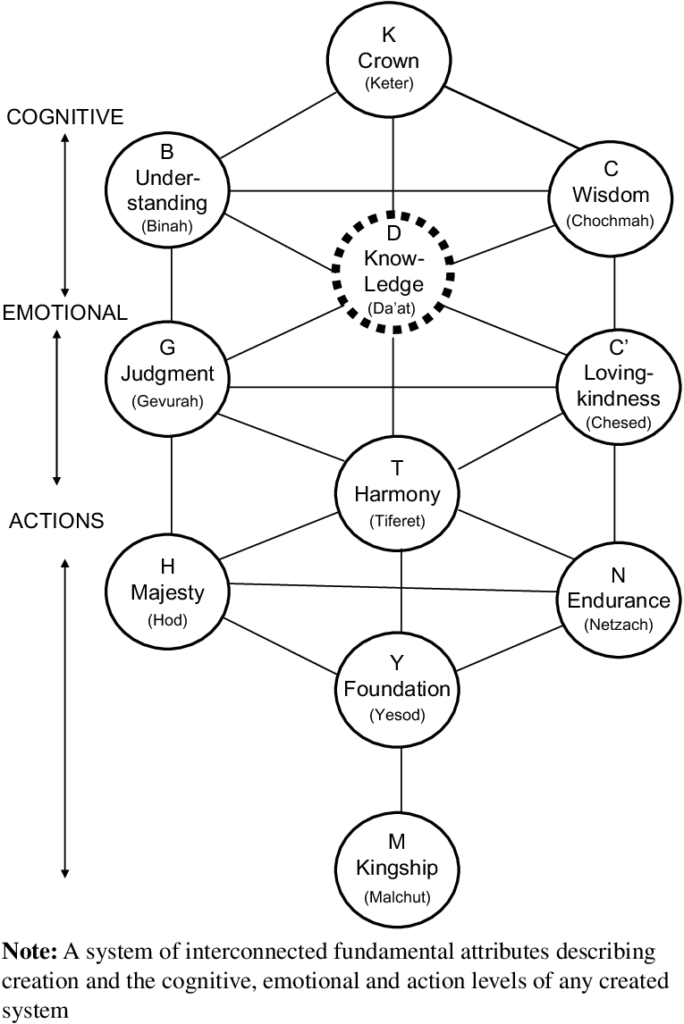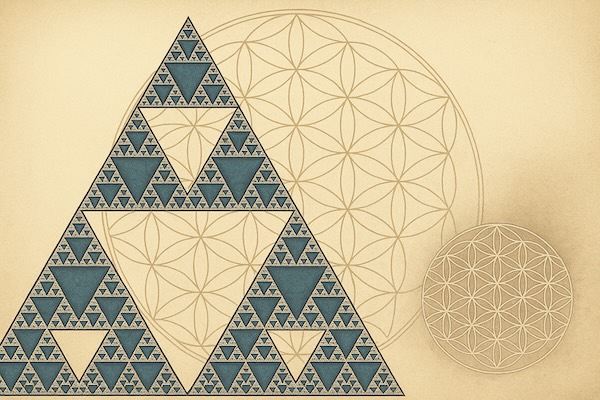In the convergence of ancient wisdom and modern psychology lies a profound opportunity—to understand the human psyche through frameworks that have guided seekers for millennia while honoring the rigor that contemporary science demands. The Tree of Life Personality Test represents exactly this synthesis, offering a scientifically grounded exploration of consciousness through the archetypal lens of Kabbalah’s most enduring symbol.
As a psychologist I have always been familiar with psychometrics, being able to translate into metrics behavioural and cognitive aspects of human psychology is fascinating. This time I had the idea to try this with a different approach, use a Likert Scale type test classifying the imbalances in the tree of life as traits of personality. After testing the items I have realized the results are pretty consistent. The characteristics of the personality traits in the sephira or dimensions of the Tree of Life are so relatable to personality traits that the test actually works. Below I explain the science behind it.

You can access the test here https://treeoflife.transcendentpsychology.com/questionnaire
Where Mysticism of the Tree of Life Meets Personality Assessment
The Tree of Life, or Etz Chaim in Hebrew, has served for over two thousand years as a map of consciousness, describing how divine emanation flows through ten distinct spheres of existence called the Sephirot. Each Sephira represents a fundamental quality of awareness—from the ineffable crown of pure being (Keter) to the grounded kingdom of manifest reality (Malkuth). What makes this framework particularly compelling from a psychological perspective is its recognition that these qualities can exist in both deficiency and excess, creating the very imbalances that often bring individuals to therapy or spiritual practice.
Consider how this mirrors what we observe clinically: a person might struggle with boundaries (deficient Gevurah—the sphere of strength and discipline) while simultaneously being overly rigid in their thinking (excessive Binah—the sphere of understanding). Traditional personality assessments often capture traits in isolation, but the Tree of Life reveals the dynamic interplay between complementary aspects of consciousness.
Origins & Foundations
The Sephirot Test draws inspiration from two pillars of esoteric wisdom:
- Sefer Yetzirah The Book of The Tree of Life — Ten Sephirot plus 22 letters chart the blueprint of creation and consciousness.
- The Ten Emanations — From Keter (Crown), the spark of divine will, through Malkuth (Kingdom), the realm of embodiment, each Sephira maps a core human capacity.
These archetypes become the scaffold for modern inquiry, inviting you to witness where you may be under-expressing your innate strengths or over-extending certain traits.

Designing the Experience
At its heart, the Tree of Life Personality Test is a balanced, 60-item questionnaire—six questions per Sephira—that probes both deficiency (what you may be missing) and excess (what you may be over-doing). Each prompt is presented as a single “card,” guiding you through a gentle progression of insights without overwhelm.
- Mobile-First Layout ensures seamless engagement on any device.
- Likert-Style Scaling (0 = never, 4 = always) captures subtle shades of your inner life.
- Real-Time Persistence safeguards your responses in the cloud (via Upstash) or local storage, so you can pause and return at will.
Take the test here https://treeoflife.transcendentpsychology.com/
Understand each Sefira in your Tree of Life
Below is a concise list of the ten sefirot, each framed as a core psychological function, with its potential excess (over-activation) and lack (under-activation):
- Keter (Crown)
• Psychological Function: Meta-awareness, overarching will or sense of purpose
• Excess: Grandiosity, spiritual bypassing or dissociation from everyday reality
• Lack: Apathy, lack of direction, existential emptiness - Chokhmah (Wisdom)
• Psychological Function: Spontaneous insight, intuitive “flash”
• Excess: Impulsivity, manic ideation, restlessness of mind
• Lack: Rigidity, mental blocks, inability to see new possibilities - Binah (Understanding)
• Psychological Function: Analytical processing, structure and meaning-making
• Excess: Overthinking, paralysis by analysis, perfectionism
• Lack: Superficiality, fragmentation of experience, poor problem-solving - Chesed (Mercy/Loving-kindness)
• Psychological Function: Generosity, unconditional warmth, openness
• Excess: Boundary collapse, codependency, people-pleasing
• Lack: Coldness, withdrawal, inability to give or receive care - Gevurah (Strength/Judgment)
• Psychological Function: Discipline, healthy limits, courageous discernment
• Excess: Harshness, overly rigid rules, punitive self-criticism
• Lack: Weak boundaries, indecision, susceptibility to exploitation - Tiferet (Beauty/Integration)
• Psychological Function: Harmonizing center, authentic self-expression
• Excess: Narcissism, self-absorption, grand theatricality
• Lack: Fragmented identity, low self-regard, loss of meaning - Netzach (Eternity/Victory)
• Psychological Function: Persistence, resilient drive, long-term vision
• Excess: Obsession, workaholism, relentless striving
• Lack: Passivity, procrastination, giving up too soon - Hod (Glory/Splendor)
• Psychological Function: Clarity of communication, reflection, learning
• Excess: Over-intellectualization, endless analysis, talkativeness
• Lack: Poor self-expression, difficulty articulating needs or insights - Yesod (Foundation)
• Psychological Function: Emotional connection, trust, grounding of inner life
• Excess: Daydreaming, fantasy-addiction, boundary-blurring in imagination
• Lack: Insecurity, emotional flatness, dissociation - Malkhut (Kingdom)
• Psychological Function: Embodiment, presence in the here-and-now, practical action
• Excess: Materialism, ego-entrenchment, over-identification with roles
• Lack: Dissociation, lack of presence, feeling unrooted in one’s life.
- Psychodynamic Integration By pairing each Sephirah with targeted multiple-choice items—half probing under-expression (“deficiency”) and half probing over-expression (“excess”)—the Sephirot Test operationalizes mystical archetypes into measurable psychological constructs.
Bringing Results to Life
On completing all 60 cards, you’ll be greeted by:
- Radar Chart Visualization tracing your unique “fingerprint” across the ten Sephirot.
- Numerical Scores that highlight areas of imbalance.
- Interpretive Commentary weaving together Kabbalistic symbolism and psychodynamic insights, pointing you toward practical next steps.
From Ancient Symbol to Interactive Insight
What transforms this mystical framework into a practical assessment tool is its integration with rigorous psychometric methodology. The test employs validated measurement principles—Likert scaling, balanced item design, and systematic scoring algorithms—to generate both numerical profiles and rich visual representations of individual patterns.
Upon completion, users receive a radar chart that maps their unique psychological landscape across all ten Sephirot, revealing at a glance where energy flows freely and where blockages or imbalances might exist. This visual representation often produces profound “aha” moments, as individuals recognize patterns they’ve sensed but never articulated.
The scoring system converts raw responses into percentage scales, allowing for meaningful comparison between different aspects of personality while maintaining the relational context that makes the Tree of Life framework so powerful. Rather than reducing complexity to simple categories, the assessment honors the intricate dance of consciousness that defines human experience.
Why the Sephirot Test Matters
This assessment is more than a quiz—it’s an integrative practice that:
- Illuminates Self-Awareness by translating ancient archetypes into actionable feedback.
- Supports Personal Growth with tailored suggestions for reflection, journaling, or therapeutic work.
- Enriches Professional Practice, offering therapists, coaches, and spiritual guides a fresh framework for intake and exploration.
Your Next Steps
- Begin the Journey at TranscendentPsychology.com—enter your name, then immerse yourself in sixty evocative moments of self-reflection.
- Review Your Profile—explore your radar chart, consider where you feel energized or held back.
- Take Action—use the interpretive notes to craft a personalized growth plan, whether through meditation, creative practice, or guided therapy.
This test will be a step towards a mystical path where ancient Kabbalah and modern psychology converge.







